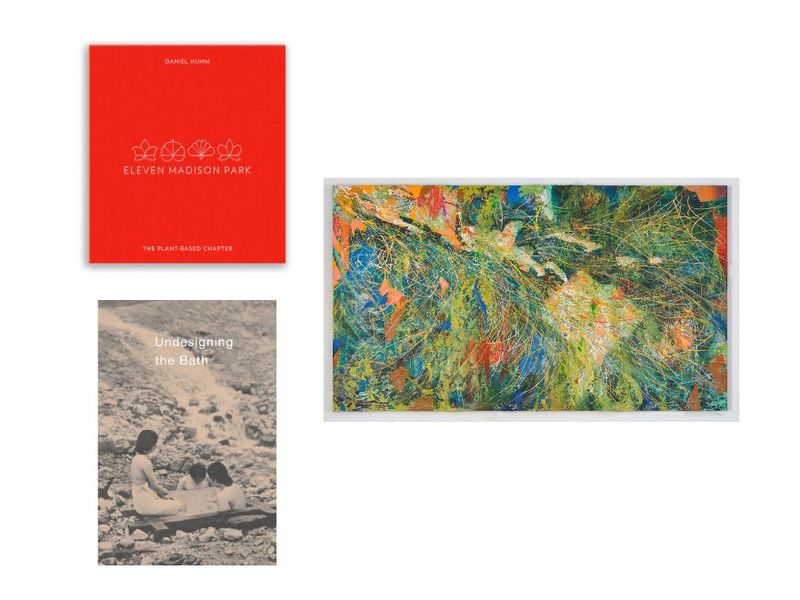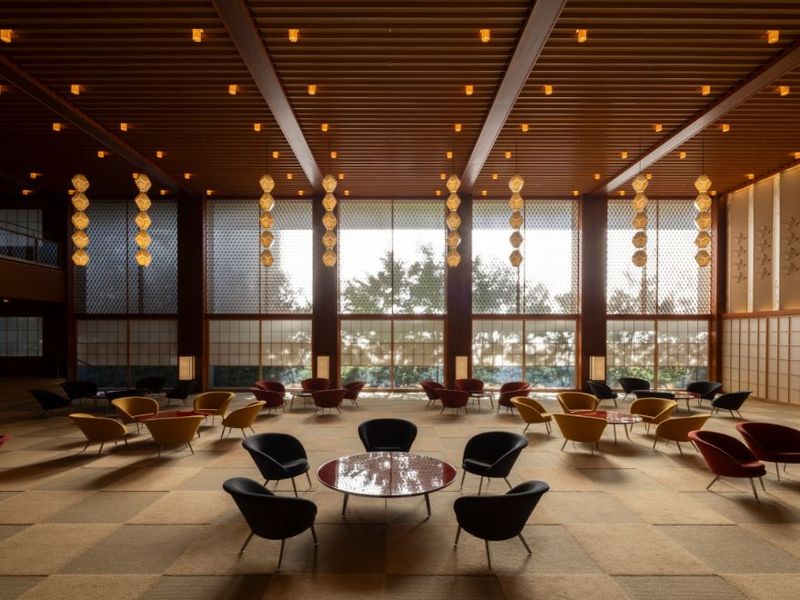In this week’s newsletter, we ponder the meaning of hospitality with The Alpina Gstaad’s Nachson Mimran, soak up Leonard Koren’s newly reissued book about bathing, check in at The Okura Tokyo hotel, find hope in the words of Rebecca Solnit, and more.
Good morning!
As I type this, I’m thinking back to my interview earlier this fall with the humanitarian and entrepreneur Nachson Mimran at a two-day “hospitality event” in Copenhagen called The Lobby, where we recorded a live taping of Time Sensitive, released this week as Ep. 122. During our conversation, Nachson talked about his experiences living and working between Gstaad in the Swiss Alps—home to the plush, five-star Alpina Gstaad hotel, which he co-founded and is the creative director of—and refugee settlements in the Global South, where his organization to.org continues to build transformative spaces and projects for culture, art, and well-being. Though these places may seem to be opposites, he says, he has nonetheless found in them much commonality and a shared definition of hospitality.
It’s practically impossible to fully capture all of Nachson’s efforts at The Alpina Gstaad and to.org here, but if there’s any one way I’d describe him, it would be as a platform-builder. With the mission of scaling decarbonization, refugee empowerment, and, to use his phrase, “human optimization,” to.org is making deep impacts through its multifarious design and development efforts, including the recently completed Bidi Bidi Performing Arts Centre in Uganda; a 3D-printed toilet, made using upcycled plastic from medical equipment; and the Sumayya Vally–designed Regenerate wellness center, currently in the works at Kenya’s Kakuma refugee settlement.
Unlike so many who come from highly privileged backgrounds such as Nachson’s—his family owns one of the largest agri-industrial businesses in West Africa—he is open and forthright when it comes to talking about his inheritance and the responsibility he sees of doing good with it. And through to.org he’s bringing together various “creative activists,” from venture funders and futurists to designers, environmentalists, and artists, to help him achieve his goals.
His work reminds me, in various ways, of the heart-centered leadership of Tina Roth Eisenberg (Ep. 82), the humanitarian entrepreneurship of Mikkel Vestergaard Frandsen (Ep. 84), the visionary hospitality of Ian Schrager (Ep. 100), and the uplifting philanthropy of Maggie Doyne (Ep. 12). I suppose that’s one of the ultimate aims of Time Sensitive, after all: to highlight courageous and curious people who, in the face of incredible challenges, make great positive change in the world.
—Spencer
“Talent is equally distributed, but opportunity isn’t.” —Nachson Mimran
Listen to Ep. 122 at timesensitive.fm or wherever you get your podcasts

Undesigning the Bath (Blunk Books)
A quarter century after its initial publication, and long since it went out of print, the cult book Undesigning the Bath by Leonard Koren has been rejuvenated and reissued by Blunk Books in collaboration with Koren, the designer Charles De Lisle, and the graphic designer Kajsa Ståhl. This book celebrates the idea that bathing experiences should be elemental, earthy, and organic, and that design, therefore, is antithetical to the most essential form of bathing. Writes Koren: “Undesigned baths—that is, naturalistic baths stripped of all ego and artifice—are particularly conducive to slowing things down (and in the process transforming us back into ourselves).”
Eleven Madison Park: The Plant-Based Chapter (Voracious)
When Eleven Madison Park’s chef-owner, Daniel Humm (the guest on Ep. 53 of Time Sensitive), announced in 2021 that the acclaimed restaurant would reopen with an entirely plant-based menu, it made international headlines. Since that transition, however, the restaurant has continued to do what it has always done best—showcasing, in an artful way, the wide-ranging and often surprising possibilities of the ingredients Humm and his team choose and use. This limited-edition set of books chronicles Eleven Madison Park’s evolution into the first plant-based restaurant ever to earn three Michelin stars. Comprising three volumes—one with a letter by Humm and six of his illustrations, one with recipes, and one featuring photojournalism by the photographer Ye Fan—each slipcased set is signed by Humm and individually hand-numbered.
“José Parlá: Homecoming” at Pérez Art Museum Miami
An ode to his multicultural upbringing between Miami and Puerto Rico and his first solo museum exhibition in his hometown, “José Parlá: Homecoming,” on view through July 6, 2025, is a two-part show that will see the artist paint a site-specific mural in real time for the first iteration of the exhibition, and, for the second, transform the space into a studio—a room full of paint-covered tables, a sprawling Cuban-inspired record collection, and decades of his archival belongings. Following his recovery from a life-threatening case of Covid-19 in 2021, which Parlá spoke about at length on Ep. 95 of Time Sensitive, the presentation represents not only a homecoming to Miami, but also a return to himself and his practice after this harrowing experience.

Immediately upon entering The Okura Tokyo, located in the city’s dense Toranomon business district, an “Okura aura” will wash over you. Step through the front door to the check-in desk of this vast, 508-room property, and an impressive choreography will ensue, swiftly transitioning you into an entirely different space of mind, body, and spirit. A world of Japanese simplicity, elegance, tradition, and innovation will seamlessly unfold. You may experience awe, or maybe even a floating feeling, as if you’re in an ethereal dream. This hotel is so exquisite, so well-run, thought-through, and considered, that it seems almost too perfect for this world.
Since opening in 1962, The Okura’s mission has been “best accommodation, best cuisine, best service,” and it shows. To that, we would like to unofficially add: “best design.” Though the original hotel, a midcentury icon designed by Yoshiro Taniguchi (1904–1979), was torn down to some controversy and lamentation in 2015, this clean slate made way for a sublimely sensitive overhaul and expansion: two new glass-curtained structures, the Prestige Tower and the adjacent Heritage Wing, opened in 2019 with interiors by Yoshiro’s son, the renowned architect Yoshio Taniguchi.
Rich in history and representative of Japanese culture, this is a place that honors its lasting heritage at every turn. The lobby, first designed by Yoshiro, was painstakingly recreated and resurrected by Yoshio, who treated it with the utmost reverence and care, as something hisei, or sacred, passed from father to son. Extraordinarily, and with a forensic level of investigative detail, Yoshio not only faithfully reproduced the design, materials, and layout of his father’s original creation (albeit turning the room 90 degrees), but also the atmosphere—the light, the acoustics, the temperature, the airflow, the feel.
There’s an enduring intimacy to The Okura that belies the sleek high-rise it’s located inside. Thankfully, the lobby remains the star of the show; without it, The Okura would not be The Okura. The oversized, expertly arranged flower vase; the bead-like hexahedral lanterns strung together and delicately hung from the ceiling, now updated with LEDs inside; the ornamental flower-petal textiles on the walls; the hemp-leaf kumiko lattices running along the windows; the bamboo shoji screens; the lacquered tables and chairs; and the classic world map sketch and Seiko wall clock—it’s all still there, preserved, restored, and timelessly held in place.
Beyond The Okura’s extraordinary design, it’s the omotenashi, or supreme level of hospitality and mindfulness, that pervades the property. The service is so discreetly done that it practically dissolves. For Shinji Umehara, the president and representative director of The Okura Tokyo, the hotel serves as Japan’s reception hall—something it has strived to be from the start. Located across the street from the U.S. embassy and the U.S. ambassador’s residence, there is indeed a diplomatic—if decidedly low-key and unfussy—nature to the place. The Okura Tokyo invites you in with a graceful, elegant bow, and through both its highly refined design and sensitive service says, “Irasshaimase.” Welcome.
This is a condensed and edited excerpt of a text by Spencer Bailey, published in the forthcoming book Design: The Leading Hotels of the World (Monacelli), with editorial direction by The Slowdown.
Our handpicked guide to culture across the internet.
Cultural critic Kyle Chayka considers why “human-curated guidance” and algorithmic recommendations are both banal and not all that different in the end [The New Yorker]
Debbie Millman (the guest on Ep. 51 of Time Sensitive) interviews Olafur Eliasson about altering viewers’ sensory perceptions through art [Design Matters]
Former British Vogue creative director and Jaime Perlman discusses her vision for More or Less magazine and the value of a print publication in 2024 [How Long Gone]
Journalist Elizabeth Weil explains why climate activists “souping” the Mona Lisa or a van Gogh may actually be strategic, even if these acts don’t initially seem so [New York]
Writer, historian, and activist Rebecca Solnit (the guest on the finale episode of our At a Distance podcast, released at the end of last year) finds hope in bleak times [Vanity Fair]
